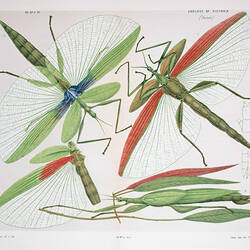Summary
This hand coloured lithograph by Arthur Bartholomew & Theresa Poole of a Reef Ocean Perch, Helicolenus percoides (originally as the Banded Red Gurnet-Perch, Sebastes percoides) was based on a specimen collected from the Victorian coast, It was commissioned in 1861 by Frederick McCoy, Director of the National Museum of Victoria, and finally published as Plate 33 in the Prodromus of the Zoology of Victoria. McCoy describes this species as "being rather rare on the Victorian coast".
This work forms part of the much larger Prodromus Collection. Many of the original illustrations in the collection informed the production of the two volume Prodromus, which was the first major publication of the National Museum of Victoria.
Bartholomew had been hired as McCoy's attendant at the Univeristy but McCoy obviously saw Bartholomew's potential for the ambitious projects which lay ahead and he soon began both a zoological and geology series for McCoy which would form the basis of the Prodromus of the Zoology of Victoria and Prodromus of the Palaeontology of Victoria. During the following four decades he illustrated more than 700 zoological specimens, along with an as-yet undocumented number of palaeontology and geological specimens. He also was commissioned to produce diagrams for the medical school. Having trained as a lithogrpaher, Bartholomew also transferred many drawings, both his own and those of other artists, onto stone for the production of lithographs.
Theressa Poole was was only commissed for a short-time during the production of the Prodromus to hand-colour 1000 copies of this plate. Although an initial sum of £10 per 1000 plates was agreed upon with Frederick McCoy, the complexity of the task eventually led to a substantial increase to £10 per 100, 'a higher price than hither to paid.'
McCoy sent the plates, in packages of 100, via the Sandridge rail to Poole's Williamstown home. As she worked from Bartholomew's original colour illustration, McCoy's regular letters guided quality control, keeping her away from artistic flourishes and within the scientific register: 'yellow being much too obtrusive & strong on the sides of several; the scarlet on edge of front dorsal fin is rather too thick and would be better if softened a little in the others, and the black spots are occasionally rather too large & heavy.'
Poole completed the 1000 plates in November 1861. Although McCoy did not employ her again, she offered 'to perpetuate Professor McCoy's features in wax, however McCoy directed his secretary to respond that 'his modesty compels him to decline with many thanks to inflict his appearance on posterity".
Description of Content
Reef Ocean Perch, Helicolenus percoides (Richardson, 1842), by Arthur Bartholomew. Hand coloured lithograph, lithographic ink, watercolour and varnish on paper, 26cm x 16cm. Published as Plate 33 in The Prodromus of the Zoology of Victoria by Frederick McCoy.
More Information
-
Collection Names
-
Collecting Areas
-
Artist
-
Artist
Theresa Poole
Theresa Poole hand-coloured the plates. -
Lithographer
-
Medium
lithographic ink, varnish and water colour on paper
-
Technique
Scientific illustration
-
Plate Number
33
-
State
Lithograph (hand coloured)
-
Classification
-
Taxon Name
-
Author and date of publication
(Richardson & Solander, 1842)
-
Preferred Common name
Reef Ocean Perch
-
Kingdom
-
Phylum
-
Subphylum
-
Superclass
-
Class
-
Order
-
Family
-
Genus
-
Species Name
percoides
-
Category
-
Discipline
-
Type of item
-
Overall Dimensions
16 cm (Width), 26 cm (Height)
-
References
[Book Series] McCoy, Frederick. 1878-1890. Natural History of Victoria: Prodromus of the Zoology of Victoria or Figures and Descriptions of the Living Species of All Classes of the Victorian Indigenous Animals. 1-2.
[Article] Yen, Alan L., et al. 2001. McCoy's Prodromus of the Zoology of Victoria: an unfinished task. Vic. Nat. 118 (6): 242-255.


